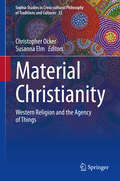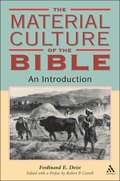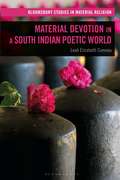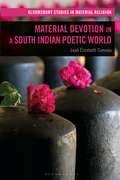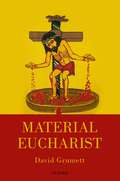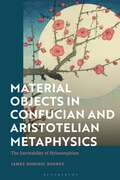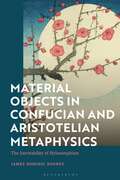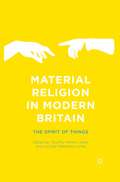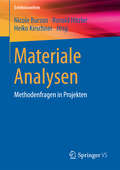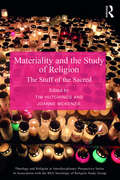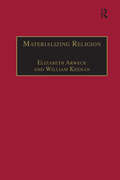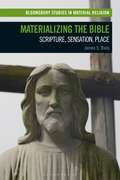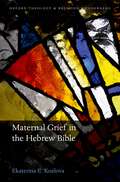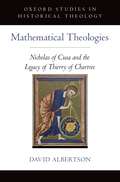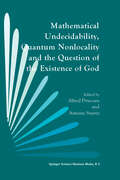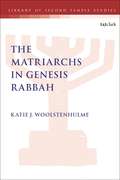- Table View
- List View
Material Christianity: Western Religion and the Agency of Things (Sophia Studies in Cross-cultural Philosophy of Traditions and Cultures #32)
by Christopher Ocker Susanna ElmThis collection of essays offers a series of rigorously focused art-historical, historical, and philosophical studies that examine ways in which materiality has posed and still poses a religious and cultural problem. The volume examines the material agency of objects, artifacts, and environments: art, ritual, pilgrimage, food, and philosophy. It studies the variable "senses” of materiality, the place of materiality in the formation of modern Western religion, and its role in Christianity’s dialogue with non-Western religions. The essays present new interpretations of religious rites and outlooks through the focus on their material components. They also suggest how material engagement theory - a new movement in cultural anthropology and archeology - may shed light on the cultural history of Christianity in medieval and early modern Europe and the Americas. It thus fills an important lacuna in the study of western religion by highlighting the longue durée, from the Middles Ages to the Modern Period, of a current dilemma, namely the divide between materialistic and what might broadly be called hermeneutical or cultural-critical approaches to religion and human subjectivity.
Material Culture and Asian Religions: Text, Image, Object (Routledge Research in Religion, Media and Culture)
by Benjamin J. Fleming Richard D. MannTraditionally, research on the history of Asian religions has been marked by a bias for literary evidence, privileging canonical texts penned in ‘classical’ languages. Not only has a focus on literary evidence shaped the dominant narratives about the religious histories of Asia, in both scholarship and popular culture, but it has contributed to the tendency to study different religious traditions in relative isolation from one another. Today, moreover, historical work is often based on modern textual editions and, increasingly, on electronic databases. What may be lost, in the process, is the visceral sense of the text as artifact – as a material object that formed part of a broader material culture, in which the boundaries between religious traditions were sometimes more fluid than canonical literature might suggest. This volume brings together specialists in a variety of Asian cultures to discuss the methodological challenges involved in integrating material evidence for the reconstruction of the religious histories of South, Southeast, Central, and East Asia. By means of specific ‘test cases,’ the volume explores the importance of considering material and literary evidence in concert. What untold stories do these sources help us to recover? How might they push us to reevaluate historical narratives traditionally told from literary sources? By addressing these questions from the perspectives of different subfields and religious traditions, contributors map out the challenges involved in interpreting different types of data, assessing the problems of interpretation distinct to specific types of material evidence (e.g., coins, temple art, manuscripts, donative inscriptions) and considering the issues raised by the different patterns in the preservation of such evidence in different locales. Special attention is paid to newly-discovered and neglected sources; to our evidence for trade, migration, and inter-regional cultural exchange; and to geographical locales that served as "contact zones" connecting cultures. In addition, the chapters in this volume represent the rich range of religious traditions across Asia – including Hinduism, Buddhism, Taoism, Shinto, and Chinese religions, as well as Islam and eastern Christianities.
Material Culture and Asian Religions: Text, Image, Object (Routledge Research in Religion, Media and Culture)
by Richard Mann Benjamin FlemingTraditionally, research on the history of Asian religions has been marked by a bias for literary evidence, privileging canonical texts penned in ‘classical’ languages. Not only has a focus on literary evidence shaped the dominant narratives about the religious histories of Asia, in both scholarship and popular culture, but it has contributed to the tendency to study different religious traditions in relative isolation from one another. Today, moreover, historical work is often based on modern textual editions and, increasingly, on electronic databases. What may be lost, in the process, is the visceral sense of the text as artifact – as a material object that formed part of a broader material culture, in which the boundaries between religious traditions were sometimes more fluid than canonical literature might suggest. This volume brings together specialists in a variety of Asian cultures to discuss the methodological challenges involved in integrating material evidence for the reconstruction of the religious histories of South, Southeast, Central, and East Asia. By means of specific ‘test cases,’ the volume explores the importance of considering material and literary evidence in concert. What untold stories do these sources help us to recover? How might they push us to reevaluate historical narratives traditionally told from literary sources? By addressing these questions from the perspectives of different subfields and religious traditions, contributors map out the challenges involved in interpreting different types of data, assessing the problems of interpretation distinct to specific types of material evidence (e.g., coins, temple art, manuscripts, donative inscriptions) and considering the issues raised by the different patterns in the preservation of such evidence in different locales. Special attention is paid to newly-discovered and neglected sources; to our evidence for trade, migration, and inter-regional cultural exchange; and to geographical locales that served as "contact zones" connecting cultures. In addition, the chapters in this volume represent the rich range of religious traditions across Asia – including Hinduism, Buddhism, Taoism, Shinto, and Chinese religions, as well as Islam and eastern Christianities.
Material Culture of the Bible: An Introduction (Biblical Seminar)
by Ferdinand DeistScholarly discussions of biblical interpretation often ignore the fact that language and literature form an integral part of a people's culture, that interpretation therefore implies the total cultural system of the relevant literature, and that biblical interpretation consequently implies inter-cultural communication. This book explores the theoretical and practical implications of this observation from a cultural anthropological perspective, looks at recent anthropological studies of ancient Israelite society, supplies practical examples of a cultural interpretation of ancient Hebrew narratives, and discusses the impact of the notions 'cultural relativity' and 'inter-cultural communication' for biblical interpretation.
Material Cultures, Migrations, and Identities: What the Eye Cannot See
by Anna PechurinaFocusing on the experiences of Russian migrants to the United Kingdom, this book explores the connection between migrations, homes and identities. It evaluates several approaches to studying them, and is structured around a series of case studies on attitudes to homemaking, food and cooking, and clothing.
Material Devotion in a South Indian Poetic World (PDF)
by Leah ComeauMaterial Devotion in a South Indian Poetic World contributes new methods for the study and interpretation of material religion found within literary landscapes. The poets of Hindu devotion are known for their intimate celebration of deities, and while verses over a thousand years old are still treasured, translated, and performed, little attention has been paid to the evocative sensorial worlds referenced by these literary compositions. This book offers a material interpretation of an understudied poem that defined an entire genre of South Asian literature -Tirukkovaiyar-the 9th-century Tamil poem dedicated to Shiva.The poetry of Tamil South India invites travel across real and imagined geography, naming royal patrons, ancient temple towns, and natural landscapes. Leah Elizabeth Comeau locates the materiality of devotion to Shiva in a world unique to the South Indian vernacular and yet captivating to audiences across time, place, and tradition.
Material Devotion in a South Indian Poetic World (Bloomsbury Studies in Material Religion)
by Leah Elizabeth ComeauMaterial Devotion in a South Indian Poetic World contributes new methods for the study and interpretation of material religion found within literary landscapes. The poets of Hindu devotion are known for their intimate celebration of deities, and while verses over a thousand years old are still treasured, translated, and performed, little attention has been paid to the evocative sensorial worlds referenced by these literary compositions. This book offers a material interpretation of an understudied poem that defined an entire genre of South Asian literature -Tirukkovaiyar-the 9th-century Tamil poem dedicated to Shiva.The poetry of Tamil South India invites travel across real and imagined geography, naming royal patrons, ancient temple towns, and natural landscapes. Leah Elizabeth Comeau locates the materiality of devotion to Shiva in a world unique to the South Indian vernacular and yet captivating to audiences across time, place, and tradition.
Material Eucharist
by David GrumettMaterial Eucharist interprets the Eucharist through its material elements of bread and wine. Drawing upon a rich variety of biblical, patristic, medieval, and modern texts and traditions, David Grumett brings together theological reflection and liturgical action and shows their mutual dependence. For both theologians and liturgists, a central concern is the matter out of which the created order has been made, from which issues of community and social justice are inseparable. The ingredients of bread and wine anticipate, in their harvesting and manufacture, the formal church liturgy, which is extended back into the world by the transformative priestly action of laypeople. Indeed, the transforming presence of Christ in the Eucharist as flesh and substance is theologically grounded in his transformative presence in the wider created order, as expressed in eucharistic giving and exchange between churches and their wider communities. Rooting the Eucharist in materiality suggests its primary context to be the death and resurrection of Christ in the power of the Spirit, in which its recipients may share. The many aspects of theology and liturgy with which the book deals have large implications for how the Eucharist is understood in a range of academic disciplines, and for how it is celebrated in churches today.
Material Eucharist
by David GrumettMaterial Eucharist interprets the Eucharist through its material elements of bread and wine. Drawing upon a rich variety of biblical, patristic, medieval, and modern texts and traditions, David Grumett brings together theological reflection and liturgical action and shows their mutual dependence. For both theologians and liturgists, a central concern is the matter out of which the created order has been made, from which issues of community and social justice are inseparable. The ingredients of bread and wine anticipate, in their harvesting and manufacture, the formal church liturgy, which is extended back into the world by the transformative priestly action of laypeople. Indeed, the transforming presence of Christ in the Eucharist as flesh and substance is theologically grounded in his transformative presence in the wider created order, as expressed in eucharistic giving and exchange between churches and their wider communities. Rooting the Eucharist in materiality suggests its primary context to be the death and resurrection of Christ in the power of the Spirit, in which its recipients may share. The many aspects of theology and liturgy with which the book deals have large implications for how the Eucharist is understood in a range of academic disciplines, and for how it is celebrated in churches today.
Material Objects in Confucian and Aristotelian Metaphysics: The Inevitability of Hylomorphism
by James Dominic RooneyHylomorphism is a metaphysical theory that explains the unity of material objects through a special immaterial part, a 'form'. While contemporary accounts of hylomorphism appeal to structure, and advocate that material substances can have other substances as parts, James Dominic Rooney highlights the flaws in this Neo-Aristotelian way of thinking. Instead, he draws on medieval European and Chinese traditions to put forward that the classical approach to the unity of material objects in terms of 'form' remains theoretically superior. Rooney shows how Thomas Aquinas' account of form gives a more coherent version of hylomorphism, eliminating the need for substance parts. He also studies the Song dynasty Confucian thinker Zhu Xi's hylomorphic intuition that whatever accounts for the composition of some parts into a material whole is a metaphysical part of that object. By appealing to the same non-Aristotelian considerations as Zhu Xi, Rooney explains why all those who believe in the unity of material objects will appeal to a form, enabling hylomorphism to remain a plausible framework. In doing so, this book shines new light on a classic philosophical problem in contemporary metaphysics and demonstrates the far-reaching points of theoretical contact between Western and Confucian thought.
Material Objects in Confucian and Aristotelian Metaphysics: The Inevitability of Hylomorphism
by James Dominic RooneyHylomorphism is a metaphysical theory that explains the unity of material objects through a special immaterial part, a 'form'. While contemporary accounts of hylomorphism appeal to structure, and advocate that material substances can have other substances as parts, James Dominic Rooney highlights the flaws in this Neo-Aristotelian way of thinking. Instead, he draws on medieval European and Chinese traditions to put forward that the classical approach to the unity of material objects in terms of 'form' remains theoretically superior. Rooney shows how Thomas Aquinas' account of form gives a more coherent version of hylomorphism, eliminating the need for substance parts. He also studies the Song dynasty Confucian thinker Zhu Xi's hylomorphic intuition that whatever accounts for the composition of some parts into a material whole is a metaphysical part of that object. By appealing to the same non-Aristotelian considerations as Zhu Xi, Rooney explains why all those who believe in the unity of material objects will appeal to a form, enabling hylomorphism to remain a plausible framework. In doing so, this book shines new light on a classic philosophical problem in contemporary metaphysics and demonstrates the far-reaching points of theoretical contact between Western and Confucian thought.
Material Religion in Modern Britain: The Spirit of Things
by Timothy Willem Jones Lucinda Matthews-JonesThis volume contributes towards to developments in the study of religion that illuminate the plural nature of religious change in modern Britain. It makes a critical intervention in British studies of religion by bringing the analytical insights of material culture, to bear on religion in the British World.
Materiale Analysen: Methodenfragen in Projekten (Erlebniswelten)
by Nicole Burzan Ronald Hitzler Heiko KirschnerIn den Beiträgen dieses Bandes zeigen namhafte Autorinnen und Autoren mittels methodologischer Reflexionen, ausgearbeiteter Forschungsdesigns und detaillierter Studien an konkreten Beispielen aus der eigenen Forschung, dass methodisch analysierte Materialien für begründete sozialwissenschaftliche Einsichten unverzichtbar sind und dass materiale Analysen den Einsatz von – zunehmend technologisch avancierten – Varianten quantitativer, qualitativer und interpretativer Datenerhebungs- und Auswertungsverfahren im Hinblick auf heterogene Forschungsinteressen an sozialen Zusammenhängen voraussetzen.
Materiality and the Study of Religion: The Stuff of the Sacred (Theology and Religion in Interdisciplinary Perspective Series in Association with the BSA Sociology of Religion Study Group)
by Tim Hutchings Joanne McKenzieMaterial culture has emerged in recent decades as a significant theoretical concern for the study of religion. This book contributes to and evaluates this material turn, presenting thirteen chapters of new empirical research and theoretical reflection from some of the leading international scholars of material religion. Following a model for material analysis proposed in the first chapter by David Morgan, the contributors trace the life cycle of religious materiality through three phases: the production of religious objects, their classification as religious (or non-religious), and their circulation and use in material culture. The chapters in this volume consider how objects become and cease to be sacred, how materiality can be used to contest access to public space and resources, and how religion is embodied and performed by individuals in their everyday lives. Contributors discuss the significance of the materiality of religion across different religious traditions and diverse geographical regions, paying close attention to gender, age, ethnicity, memory and politics. The volume closes with an afterword by Manuel Vásquez.
Materiality and the Study of Religion: The Stuff of the Sacred (Theology and Religion in Interdisciplinary Perspective Series in Association with the BSA Sociology of Religion Study Group)
by Tim Hutchings Joanne McKenzieMaterial culture has emerged in recent decades as a significant theoretical concern for the study of religion. This book contributes to and evaluates this material turn, presenting thirteen chapters of new empirical research and theoretical reflection from some of the leading international scholars of material religion. Following a model for material analysis proposed in the first chapter by David Morgan, the contributors trace the life cycle of religious materiality through three phases: the production of religious objects, their classification as religious (or non-religious), and their circulation and use in material culture. The chapters in this volume consider how objects become and cease to be sacred, how materiality can be used to contest access to public space and resources, and how religion is embodied and performed by individuals in their everyday lives. Contributors discuss the significance of the materiality of religion across different religious traditions and diverse geographical regions, paying close attention to gender, age, ethnicity, memory and politics. The volume closes with an afterword by Manuel Vásquez.
Materializing Religion: Expression, Performance and Ritual (Theology and Religion in Interdisciplinary Perspective Series in Association with the BSA Sociology of Religion Study Group)
by William KeenanThe material symbol has become central to understanding religion in late modernity. Overtly theological approaches use words to express the values and faith of a religion, but leave out the 'incarnation' of religion in the behavioural, performative, or audio-visual form. This book explores the lived experience of religion through its material expressions, demonstrating how religion and spirituality are given form and are thus far from being detached or ethereal. Cutting across cultures, senses, disciplines and faiths, the contributors register the variety in which religions and religious groups express the sacred and numinous. Including chapters on music, architecture, festivals, ritual, artifacts, dance, dress and magic, this book offers an invaluable resource to students of sociology and anthropology of religion, art, culture, history, liturgy, theories of late modern culture, and religious studies.
Materializing Religion: Expression, Performance and Ritual (Theology and Religion in Interdisciplinary Perspective Series in Association with the BSA Sociology of Religion Study Group)
by William KeenanThe material symbol has become central to understanding religion in late modernity. Overtly theological approaches use words to express the values and faith of a religion, but leave out the 'incarnation' of religion in the behavioural, performative, or audio-visual form. This book explores the lived experience of religion through its material expressions, demonstrating how religion and spirituality are given form and are thus far from being detached or ethereal. Cutting across cultures, senses, disciplines and faiths, the contributors register the variety in which religions and religious groups express the sacred and numinous. Including chapters on music, architecture, festivals, ritual, artifacts, dance, dress and magic, this book offers an invaluable resource to students of sociology and anthropology of religion, art, culture, history, liturgy, theories of late modern culture, and religious studies.
Materializing the Bible: Scripture, Sensation, Place (Bloomsbury Studies in Material Religion)
by James S. BieloWhat happens when the written words of biblical scripture are transformed into experiential, choreographed environments? To answer this question, anthropologist James Bielo explores a diverse range of practices and places that “materialize the Bible,” including gardens, theme parks, shrines, museums, memorials, exhibitions, theatrical productions, and other forms of replication. Integrating ethnographic, archival, and mass media data, case studies focus primarily on U.S. Christianity from the late 19th-century to the present. Composed as 20 short chapters that may be read in any order, the book is divided into three sections. Section I, “Variations on Replication,” analyzes examples that recontextualize elements from the (actual or imagined) biblical past. Section II, “The Power of Nature,” turns to the natural world associated with Christian scripture and how it is mobilized as a privileged media. Section III, “Choreographing Experience,” examines lived interactions with the affordances of materializing the Bible. Bielo argues that materializing the Bible works as an authorizing practice to intensify intimacies with scripture and circulate potent ideologies. Performed through the sensory experience of bodies, physical technologies, and infrastructures of place, Bielo illustrates how this phenomenon is always, ultimately, about expressions of power.
Materializing the Bible: Scripture, Sensation, Place (Bloomsbury Studies in Material Religion)
by James S. BieloWhat happens when the written words of biblical scripture are transformed into experiential, choreographed environments? To answer this question, anthropologist James Bielo explores a diverse range of practices and places that “materialize the Bible,” including gardens, theme parks, shrines, museums, memorials, exhibitions, theatrical productions, and other forms of replication. Integrating ethnographic, archival, and mass media data, case studies focus primarily on U.S. Christianity from the late 19th-century to the present. Composed as 20 short chapters that may be read in any order, the book is divided into three sections. Section I, “Variations on Replication,” analyzes examples that recontextualize elements from the (actual or imagined) biblical past. Section II, “The Power of Nature,” turns to the natural world associated with Christian scripture and how it is mobilized as a privileged media. Section III, “Choreographing Experience,” examines lived interactions with the affordances of materializing the Bible. Bielo argues that materializing the Bible works as an authorizing practice to intensify intimacies with scripture and circulate potent ideologies. Performed through the sensory experience of bodies, physical technologies, and infrastructures of place, Bielo illustrates how this phenomenon is always, ultimately, about expressions of power.
Maternal Grief in the Hebrew Bible (Oxford Theology and Religion Monographs)
by Ekaterina E. KozlovaSetting out from the observation made in the social sciences that maternal grief can at times be a motor of societal change, Ekaterina E. Kozlova demonstrates that a similar mechanism operates also in the biblical world. Kozlova argues that maternal grief is treated as a model or archetype of grief in biblical and Ancient Near Eastern literature. The work considers three narratives and one poem that illustrate the transformative power of maternal grief in the biblical presentation: Gen 21, Hagar and Ishmael in the desert; 2 Sam 21: 1-14, Rizpah versus King David; 2 Sam 14, the speech of the Tekoite woman; Jer 31: 15-22, Rachel weeping for her children. Although only one of the texts literally refers to a bereaved mother (2 Sam 21 on Rizpah), all four passages draw on the motif of maternal grief, and all four stage some form of societal transformation.
Maternal Grief in the Hebrew Bible (Oxford Theology and Religion Monographs)
by Ekaterina E. KozlovaSetting out from the observation made in the social sciences that maternal grief can at times be a motor of societal change, Ekaterina E. Kozlova demonstrates that a similar mechanism operates also in the biblical world. Kozlova argues that maternal grief is treated as a model or archetype of grief in biblical and Ancient Near Eastern literature. The work considers three narratives and one poem that illustrate the transformative power of maternal grief in the biblical presentation: Gen 21, Hagar and Ishmael in the desert; 2 Sam 21: 1-14, Rizpah versus King David; 2 Sam 14, the speech of the Tekoite woman; Jer 31: 15-22, Rachel weeping for her children. Although only one of the texts literally refers to a bereaved mother (2 Sam 21 on Rizpah), all four passages draw on the motif of maternal grief, and all four stage some form of societal transformation.
Mathematical Theologies: Nicholas of Cusa and the Legacy of Thierry of Chartres (Oxford Studies in Historical Theology)
by David AlbertsonThe writings of theologians Thierry of Chartres (d. 1157) and Nicholas of Cusa (d. 1464) represent a lost history of momentous encounters between Christianity and Pythagorean ideas before the Renaissance. Their robust Christian Neopythagoreanism reconceived the Trinity and the Incarnation within the framework of Greek number theory, challenging our contemporary assumptions about the relation of religion and modern science. David Albertson surveys the slow formation of theologies of the divine One from the Old Academy through ancient Neoplatonism into the Middle Ages. Against this backdrop, Thierry of Chartres's writings stand out as the first authentic retrieval of Neopythagoreanism within western Christianity. By reading Boethius and Augustine against the grain, Thierry reactivated a suppressed potential in ancient Christian traditions that harmonized the divine Word with notions of divine Number. Despite achieving fame during his lifetime, Thierry's ideas remained well outside the medieval mainstream. Three centuries later Nicholas of Cusa rediscovered anonymous fragments of Thierry and his medieval readers, and drew on them liberally in his early works. Yet tensions among this collection of sources forced Cusanus to reconcile their competing understandings of Word and Number. Over several decades Nicholas eventually learned how to articulate traditional Christian doctrines within a fully mathematized cosmology-anticipating the situation of modern Christian thought after the seventeenth century. Mathematical Theologies skillfully guides readers through the newest scholarship on Pythagoreanism, the school of Chartres, and Cusanus, while revising some of the categories that have separated those fields in the past.
Mathematical Theologies Osht C: Nicholas Of Cusa And The Legacy Of Thierry Of Chartres
by David AlbertsonMathematical Undecidability, Quantum Nonlocality and the Question of the Existence of God
by A. Driessen Antoine SuarezOn January 22, 1990, the late John Bell held at CERN (European Laboratory for Particle Physics), Geneva a seminar organized by the Center of Quantum Philosophy, that at this time was an association of scientists interested in the interpretation of quantum mechanics. In this seminar Bell presented once again his famous theorem. Thereafter a discussion took place in which not only physical but also highly speculative epistemological and philosophical questions were vividly debated. The list of topics included: assumption of free will in Bell's theorem, the understanding of mind, the relationship between the mathematical and the physical world, the existence of unobservable causes and the limits of human knowledge in mathematics and physics. Encouraged by this stimulating discussion some of the participants decided to found an Institute for Interdisciplinary Studies (lIS) to promote philosoph ical and interdisciplinary reflection on the advances of science. Meanwhile the lIS has associated its activities with the Swiss foundation, Fondation du Leman, and the Dutch foundation, Stichting Instudo, registered in Geneva and Amsterdam, respectively. With its activities the lIS intends to strengthen the unity between the professional activities in science and the reflection on fun damental philosophical questions. In addition the interdisciplinary approach is expected to give a contribution to the progress of science and the socio economic development. At present three working groups are active within the lIS, i. e. : - the Center for Quantum Philosophy, - the Wealth Creation and Sustainable Development Group, - the Neural Science Group.
The Matriarchs in Genesis Rabbah (The Library of Second Temple Studies)
by Katie J. WoolstenhulmeKatie J. Woolstenhulme considers the pertinent questions: Who were 'the matriarchs', and what did the rabbis think about them? Whilst scholarship on the role of women in the Bible and Rabbinic Judaism has increased, the authoritative group of women known as 'the matriarchs' has been neglected. This volume consequently focuses on the role and status of the biblical matriarchs in Genesis Rabbah, the fifth century CE rabbinic commentary on Genesis. Woolstenhulme begins by discussing the nature of midrash and introducing Genesis Rabbah; before exploring the term 'the matriarchs' and its development through early exegetical literature, culminating in the emergence of two definitions of the term in Genesis Rabbah – 'the matriarchs' as the legitimate wives of Israel's patriarchs, and 'the matriarchs' as a reference to Jacob's four wives, who bore Israel's tribal ancestors. She then moves to discuss 'the matriarchal cycle' in Genesis Rabbah with its three stages of barrenness; motherhood; and succession. Finally, Woolstenhulme considers Genesis Rabbah's portrayal of the matriarchs as representatives of the female sex, exploring positive and negative rabbinic attitudes towards women with a focus on piety, prayer, praise, beauty and sexuality, and the matriarchs' exemplification of stereotypical, negative female traits. This volume concludes that for the ancient rabbis, the matriarchs were the historical mothers of Israel, bearing covenant sons, but also the present mothers of Israel, continuing to influence Jewish identity.
